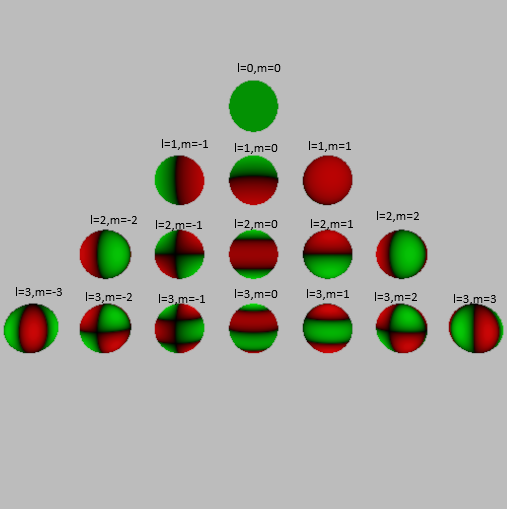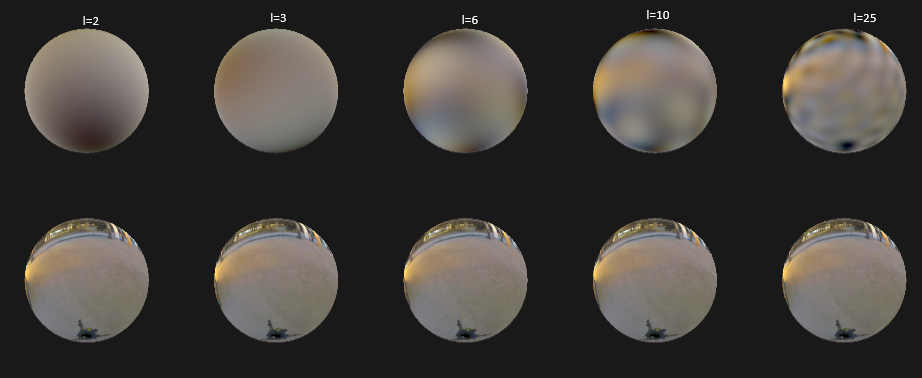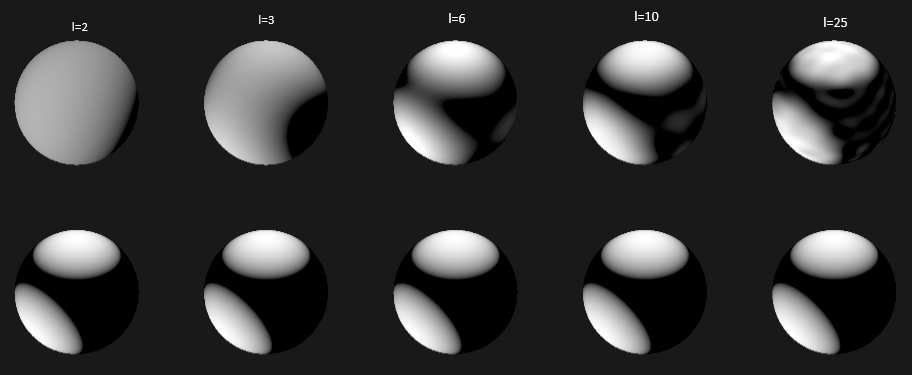waizui
Spherical Harmonic Lighting
Introduction
Spherical Harmonic lighting (SH lighting) is a technique for calculating the lighting on 3D models from area light sources that allows us to capture, relight and display global illumination style images in real time.
You can skip the following complicated mathematical definitions and directly read the example parts for better understanding. The example code can be found there.
The definition of Spherical Harmonic function is:
\[\begin{align} &Y_\ell^m(\theta,\phi) = Ne^{im\phi}P_\ell^m(\cos\theta) \\ &where \ \ell \in \{0,1,2,3,\cdots\} , m \in [-\ell, \ell] \end{align}\]The $\ell$ is degree(band index) of $Y$, $m$ is order of $Y$, N is a normalization constant. $P_\ell^m(x)$ is associated Legendre polynomial, which can be definied use recurrence formula as:
\[\begin{align} (\ell-m)P_\ell^m &= x(2\ell-1)P_{\ell-1}^m-(\ell+m-1)P_{\ell-2}^m \\ P_m^m &= (-1)^m(2m-1)!!(1-x^2)^{m/2} \\ P_{m+1}^m &= x(2m+1)P_m^m \\ \end{align}\]with $!!$ is double factorial, which can be expressed as:
\[\begin{align} n!! &= \prod_{k=0}^{\left\lceil \frac{n}{2} \right\rceil - 1} (n - 2k) = n(n - 2)(n - 4)\cdots \\ \end{align}\]for even n:
\[\begin{align} n!! &= \prod_{k=0}^{\frac{n}{2} } (2k) = n(n - 2)(n - 4)\cdots 4\cdot 2 \\ \end{align}\]for odd n:
\[\begin{align} n!! &= \prod_{k=0}^{\frac{n+1}{2} } (2k-1) = n(n - 2)(n - 4)\cdots 3\cdot 1 \\ \end{align}\]The SH functions are defined on imaginary numbers but we are only interested in approximating real functions, only real form of SH was used there:
\[\begin{align} y_\ell^m(\theta, \phi) &= \begin{cases} \sqrt{2} K_\ell^m \cos(m\phi) P_\ell^m(\cos\theta), & m > 0 \\ \sqrt{2} K_\ell^{|m|} \sin(-m\phi) P_\ell^{|m|}(\cos\theta), & m < 0 \\ K_\ell^0 P_\ell^0(\cos\theta), & m = 0 \end{cases} \\ K_\ell^m &= \sqrt{\frac{(2\ell + 1)(\ell - |m|)!}{4\pi\, (\ell + |m|)!}} \end{align}\]Define sequence $y_i$ of $y_\ell^m$ can be useful:
\[\begin{align} y_\ell^m(\theta, \phi) = y_i(\theta, \phi), \ where \ i=\ell(\ell+1)+m \end{align}\]Ok! These are all the mathematical definitions we need.
Plot Spherical Harmonicas!
A rust implementation of associated Legendre polynomial $P_\ell^m$ using recurrence formula is:
fn P(l: i32, m: i32, x: f32) -> f32 {
assert!(m >= 0);
let mut pmm = 1f32;
// evaluate P(m,m) from P(0,0)
if m > 0 {
let sqrtfactor = ((1f32 - x) * (1f32 + x)).sqrt();
let mut fact = 1f32;
for _ in 0..m {
pmm *= (-fact) * sqrtfactor;
fact += 2f32;
}
}
if l == m {
return pmm;
}
let mut pmm1 = x * (2f32 * m as f32 + 1f32) * pmm;
if l == m + 1 {
return pmm1;
}
let mut pll = 0f32;
for ll in m + 2..l + 1 {
pll = (x * (2 * ll - 1) as f32 * pmm1 - (ll + m - 1) as f32 * pmm) / (ll - m) as f32;
pmm = pmm1;
pmm1 = pll;
}
pll
}
The normalization constant $K_\ell^m$:
fn factorial(x: i32) -> f32 {
if x == 0 {
return 1f32;
}
(1..x + 1).fold(1., |acc, x| acc * x as f32)
}
fn K(l: i32, m: i32) -> f32 {
let fac0 = (2f32 * l as f32 + 1f32) / (4f32 * PI);
let fac1 = factorial(l - m) / factorial(l + m);
let res = fac0 * fac1;
res.sqrt()
}
Then the shperical harmonic function $y_\ell^m$:
/// l [0,N], m [-l,l]
/// real part of spherical harmonics
fn sh_real(l: i32, m: i32, theta: f32, phi: f32) -> f32 {
if m == 0 {
return K(l, m) * P(l, m, theta.cos());
}
let sqrt2 = 2f32.sqrt();
if m > 0 {
return sqrt2 * K(l, m) * (m as f32 * phi).cos() * P(l, m, theta.cos());
}
let m = -m;
sqrt2 * K(l, m) * (m as f32 * phi).sin() * P(l, m, theta.cos())
}
Draw the value of $y_\ell^m$ onto a sphere’s surface, use green representing positive values, red for negative values. we can get following picture:

Projection and Reconstruction
Projecting a spherical function into SH coefficients is very simple, $S$ is the sphere:
\[\begin{align} c_\ell^m &= \int_Sf(s)y_\ell^m(s)ds \\ \end{align}\]or for simplexity:
\[\begin{align} \ c_i &= \int_Sf(s)y_i(s)ds \\ where\ i &= \ell(\ell+1)+m \end{align}\]For example, if I want to project a function using n degree SH, I need to calculate coefficients ${c_0,c_1,c_2,\cdots,c_{n-1}}$.
Then use these coefficients to reconstruct a approximation of original function by:
\[\begin{align} \tilde{f}(s) = \sum_{l=0}^{n-1} \sum_{m=-l}^{l} c_l^m y_l^m(s) = \sum_{i=0}^{n^2} c_i y_i(s) \end{align}\]The code below shows uisng Monte Carlo method to project environment light into SH of different degree.
/// nsamples: specify how many samples will be generated
/// return random sh samples across sphere surface
fn gen_sh_samples(nsamples: usize, l: i32) -> Vec<SHSample> {
use rs_sampler::haltonsampler::radical_inverse;
use rs_sampler::sampling::*;
let mut samples = vec![
SHSample {
sph: [0f32; 3],
xyz: [0f32; 3],
coeff: Vec::new()
};
nsamples
];
let task = |isample: usize, sample: &mut SHSample| {
// quasi-random samples
let rx: f32 = radical_inverse(isample, 2);
let ry: f32 = radical_inverse(isample, 3);
let xyz = square2unitsphere(&[rx, ry]);
let spherial = xyz2spherical(&xyz);
let theta = spherial[1];
let phi = spherial[2];
sample.xyz = xyz;
sample.sph = [1f32, theta, phi];
for il in 0..l + 1 {
for im in -il..il + 1 {
let sh = sh_real(il, im, theta, phi);
sample.coeff.push(sh);
}
}
};
// parallelly processing
samples
.par_iter_mut()
.enumerate()
.for_each(|(isample, sample)| task(isample, sample));
samples
}
fn project_sh<F>(l: i32, nsamples: usize, fr: F) -> Vec<[f32; 3]>
where
F: Fn(&[f32; 3]) -> [f32; 3] + Sync,
{
let sh_samples = gen_sh_samples(nsamples, l);
let mut coeffs = vec![[0f32; 3]; ((l + 1) * (l + 1)) as usize];
// calculate coefficient ci
let ci_task = |ic: usize, coeff: &mut [f32; 3]| {
let mut acc = [0f32; 3];
for sh_sample in sh_samples.iter().take(nsamples) {
let coeff = sh_sample.coeff[ic];
// light from environment
let light = fr(&sh_sample.xyz);
acc = acc.add(&light.scale(coeff));
}
// Monte Calor method, need to divide sample count
// and probability density function(pdf), which is 1/(4*pi) for sampling a sphere
acc = acc.scale(4f32 * PI / nsamples as f32);
*coeff = acc;
};
// parallelly processing
coeffs
.par_iter_mut()
.enumerate()
.for_each(|(ic, coeff)| ci_task(ic, coeff));
coeffs
}
This code shows how to reconstruct environment light from SH coefficients:
fn reconstruct_sh(
img: &mut [Rgb],
img_shape: (usize, usize),
coeffs: &[[f32; 3]],
l: i32,
campos: &[f32; 3],
) {
let (w, h) = img_shape;
let spheres = [Sphere {
cnt: [0f32; 3],
r: 1f32,
}];
let view = spheres[0].cnt.sub(campos);
let task = |ipix: usize, pix: &mut Rgb| {
let (iw, ih) = (ipix % w, ipix / w);
// rebuild environment light on sphere's surface
if let Some((hit, _)) = ray_cast_spheres(campos, &view, (iw, ih), (w, h), &spheres) {
let hit_pos = vec3::axpy::<f32>(hit.t, &hit.ray.d, &hit.ray.o);
let coord = worldpos2sphere(&hit_pos, &spheres[0]);
let theta = coord[1];
let phi = coord[2];
let mut res = [0f32; 3];
for il in 0..l + 1 {
for im in -il..il + 1 {
let sh = sh_real(il, im, theta, phi);
let ic = (il * (il + 1) + im) as usize;
let coeff = coeffs[ic];
// sum all products of projected coefficient multipled by respective SH basis
res = res.add(&coeff.scale(sh));
}
}
pix.0 = res;
};
};
// parallelly processing
img.par_iter_mut()
.enumerate()
.for_each(|(ipix, pix)| task(ipix, pix));
}
I’ve tested with two types of environment light. Notice that the approximated light getting more accurate while increasing degree of SH.


Masking
… To be continued